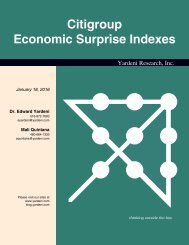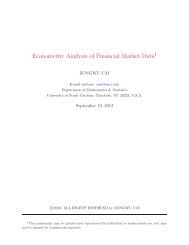Illiquid Asset Investing 1. Liquidating Harvard
Illiquid Asset Investing 1. Liquidating Harvard
Illiquid Asset Investing 1. Liquidating Harvard
Create successful ePaper yourself
Turn your PDF publications into a flip-book with our unique Google optimized e-Paper software.
Andrew Ang <strong>Illiquid</strong> <strong>Asset</strong> <strong>Investing</strong> <strong>Asset</strong> Management<br />
figure is unlikely to capture the full extent of actual losses for this period, because it does not<br />
reflect fully updated valuations in certain managed asset classes, most notably private equity and<br />
real estate.” 2<br />
<strong>Harvard</strong> relied on endowment earnings to meet a large share of university expenses. In its fiscal<br />
year ending June 30, 2008, more than one-third of operating revenue came from endowment<br />
income. For some of the university’s individual departments, the proportion was even higher: the<br />
Radcliffe Institute for Advanced Study derived 83% of its revenue from the endowment, the<br />
Divinity School 71%, and the Faculty of Arts and Sciences 52%.<br />
<strong>Harvard</strong> Management Company (HMC), the funds manager of <strong>Harvard</strong>’s endowment, was one<br />
of the early adopters of the endowment model, which recommends that long-term investors<br />
should hold lots of illiquid, alternative assets, especially private equity and hedge funds.<br />
Advocated by David Swensen in his influential book, Pioneering Portfolio Management, the<br />
endowment model was based on the economic concept of diversification originally attributable<br />
to Harry Markowitz (1952, see Chapter XX). Through diversification, a portfolio of many low-<br />
correlated assets has a risk-return trade-off superior to that of conventional portfolios consisting<br />
of only stocks and bonds. Swensen went further and advocated holding large proportions of<br />
illiquid private equity and hedge funds. Not only were these assets supposed to have low<br />
correlations to stocks and bonds, but they potentially carried an illiquidity risk premium.<br />
Swensen argued that in liquid markets, the potential for making excess returns (or “alpha,” see<br />
Chapter XX) was limited. In these markets, crowded with thousands of active managers vying<br />
for an edge, information was freely available and almost everyone has access to it. <strong>Illiquid</strong> asset<br />
2 Financial Update to the Council of Deans, December 2, 2008 from Faust and Forst.<br />
2<br />
Electronic copy available at: http://ssrn.com/abstract=2200161




